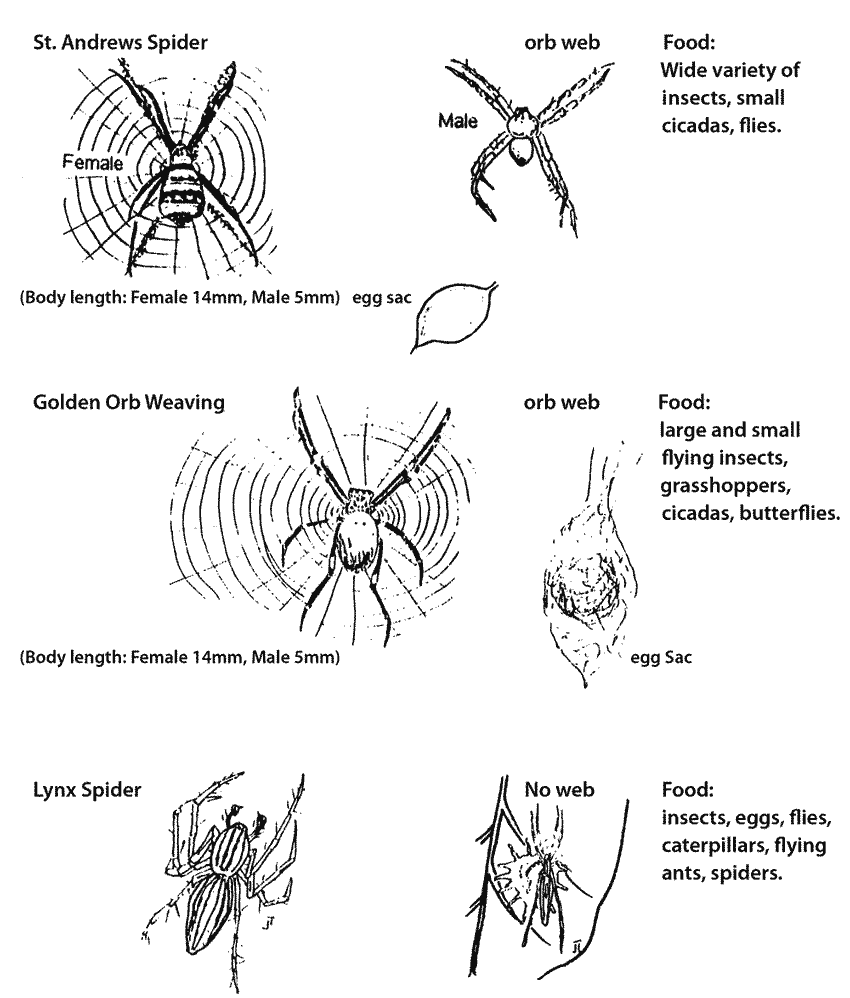
SPIDERS IN THE ORCHARD
Spiders are the unsung heros in the orchard. They work day and night feeding on insects and spiders. In fact many of us only notice them when we get caught in their sticky webs. I like spiders and decided to draw up some 8 spiders I knew we had in the custard apple orchard. How wrong I was, over 60 different spider species have made themselves known to me so far in 2 months! Some may be the opposite sex of the same species, or a juvenile, but that made me realise how many silent workers we have. The following information came my way from the DPI, and I thought everyone would be interested.
Some very interesting work has been done on spiders around the world recently and has started here in Australia in the cotton and banana industry. An extract from a paper, "The Spiders of a Citrus Grove in Israel and their Role as Biocontrol Agents", by Mansour and Whitecomb, has shown the following:
"They are predators of pest in citrus, such as Scale (Israel), Blackfly (Florida), Arthropod (California), Citrus thrips, mites, insect eggs and larvae (California), predators of egg and young larvae of citrus butterfly (Saudi Arabia), a bug in tobacco (India), Spodoptere litoralis in apples (Israel), pests in cotton (China), Heliolisin spp in cotton (SE Queensland), and insects in spruce plantations (Sweden)."
"Tests have shown that spiders are killed by Carbaryl and Formothion. Malathion did not kill 2 spiders tested." Sac and tubular retreat spiders hunt at night and return to their hides during the day which gives them some protection from the sprays.
One trial on C. floridensis (Scale) insect in Israel showed whenever spiders were undisturbed, populations of this insect were unable to develop sufficiently to cause economic damage. The trial started with no damage to leaves, nor was honeydew or sooty mould observed. Between a 14-day period from October to November, the number of Scales increased from 47 to only 56. During the same period, on branches from which spiders had been eliminated, Scales increased 7-fold from 44 to 309. Damage to infested leaves was severe and conspicuous. 116 leaves (23% of the total) were found to be heavily infested with sooty mould fungi which had developed on the honey dew produced by the Scales. Thus, whenever spiders were eliminated, this insect infestation developed unhindered and caused severe damage. On comparison of the fate of C. floridensis insect infestations in the presence and absence of spiders indicated that spider were responsible agents for the low density of the insects and for the negligible damage observed in the citrus grove. Of course, in nature conditions, spiders are free to move and other factors could be involved.
If they are so useful in the above orchards, why not our sub-tropical orchards? We have observed them eating a wide range of insects in the custard apple orchard. Fruit spotters, egg, caterpillar and butterfly of Pale Green Butterfly, rhinoceros beetle, grasshoppers, numerous unknown insects, good insects and spiders.
Spiders are not like other insects:
*They have eight legs while insects have six.
*They have eight eyes while insects have two.
*The male spider collects its own sperm and delivers it with his intricate palps (2 small leg-like appendages at its front). It is very dangerous to be a male spider after courting!
*They cover their eggs with a silk sac. Some insects do the same, but mostly they lay just the eggs.
*Their numbers build up only behind the insect numbers.
*When insects are in plague proportions they usually cause a lot of damage. Spiders do not. They eat the insects and when they have eaten them, they eat their own kind, thus reducing their numbers.
*One report said that the spiders prefer the detrimental insects to the goodies! So far in my observations over the last month its been about 50-50. Mainly bees have brought the numbers up for the goodies. Maybe the spiders know Bill doesn't need bees in the custard apple orchard!
Spider numbers are kept low by:
*Humans and by their sprays.
*Weather conditions.
*Parasitised by wasps, hornets and some flies.
*Eaten by other spiders.
*Eaten by insects, Assassin bug, Lace wings.
*Eaten by animals, Antechinus, Bandicoot, skinks, frogs, blue tongue lizards, birds and geckos.
Some common spiders with their web and egg sac that work for you

DATE: March 1993
* * * * * * * * * * * * *
